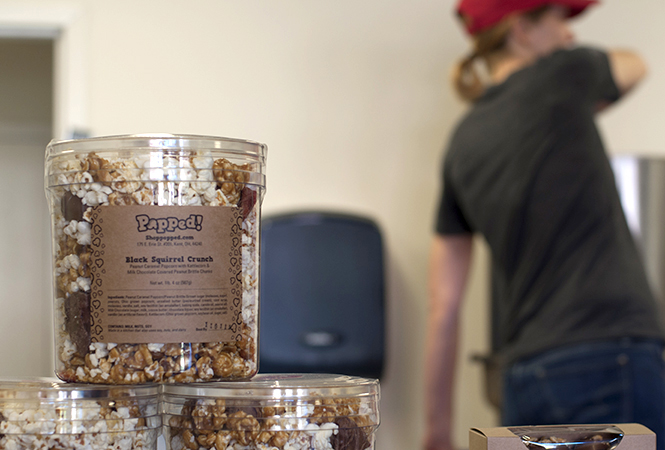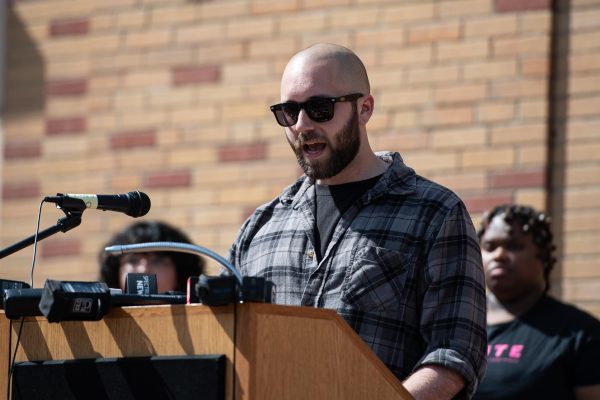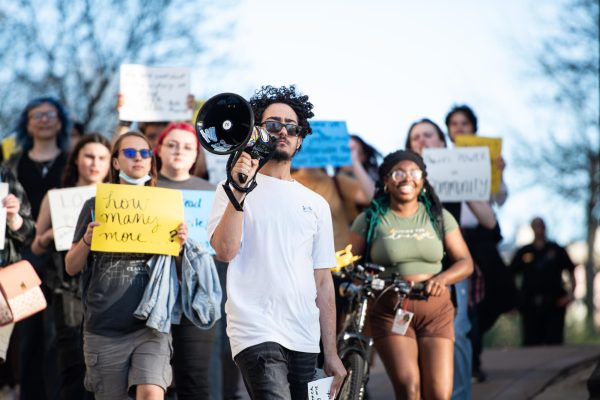Nontraditional sources of funding help propel businesses and ideas from the ground
Gwen Rosenberg, owner of Popped!, prepares a batch of caramel popcorn with butter and sea salt on Oct. 8, 2013. Photo by Brianna Neal.
October 15, 2013
When Popped! owner Gwen Rosenberg began perfecting her caramel corn recipe, it was just something she was doing for herself. But after about three years of work, she had realized she had found something special.
“It’s always sort of a really subtle evolution,” Rosenberg said. “There was no sort of drop-dead moment when I said ‘Okay. I’m going to take this recipe and start a business.’”
Rosenberg decided to start a project on Kickstarter, a website where users share their project ideas, such a product or a film, and ask others to help fund them. She started with a fundraising goal of $1,800, which is enough, she said, for some commercial equipment and other supplies.
Kickstarter by the numbers*
$708 millions of dollars that have funded projects.
50,037 projects were successfully funded.
43.89% success rate of Kickstarter.
3,912 projects are live.
*As of Oct. 15.
She ended up raising $2,715.
“To be honest, when I started the Kickstarter project, I wasn’t really sure where it was going to lead to,” Rosenberg said. “I really like it more than anything as social proofing of a concept. It’s a really quick way to get a lot of feedback, gauge interest and generate a little bit of enthusiasm.”
Kickstarter, and a few other websites such as Indiegogo, help people with ideas connect to the people who want that idea to become a reality using a process called crowdfunding.
Normally, a person who wants to start a business would have to either pay the starting costs themselves or find a few partners or investors to help invest money. Professor Murali Shanker from the College of Management and Information Systems said crowdfunding has changed that.
“The whole idea that you don’t have to rely on the classical models of raising money has shifted,” Shanker said. “It’s a great idea because we can now become investors at the base level. Not investment in the company, but investment in the potential for a product that we like.”
Rosenburg eventually decided, due to the strong response on Kickstarter, to put more of her own money into the project and buy a storefront in downtown Kent.
“At first I thought, maybe I could just do it as a farmer’s market item or maybe I’d just sell a little bit of caramel popcorn from my house just to friends,” Rosenberg said. “Once I saw the enthusiasm, I thought maybe this is more than a farmer’s market. Maybe I can do a kiosk.”
While some Kickstarter donors give money just because they would like to see an idea become real, many project-runners offer perks for donating. Rosenberg offered donors bags of popcorn and an invitation to a popcorn party at Water Street Tavern.
“In order to start a business, you need more money than what I had raised — but it was just enough to get me convinced that this was worth it,” Rosenberg said.
Rosenburg said at the top donation tier — $150 and up — she created popcorn recipes based on the donor’s preferences. One of these brands, the Baja Ohio, is now among of the shop’s most popular.
Shanker said crowdfunding brings new groups into the investment process.
“You’re tapping into not just people in the U.S. or people who have money,” Shanker said. “You contribute $10? You’re in.”
Some projects have made Rosenberg’s project look like chump change. Shanker said entrepreneur Mark Shuttleworth, famous for his work with the Ubuntu operating system, raised $12 million on an Indiegogo project for software that would allow a phone to connect to a monitor and keyboard and function as a computer.
Pay-what-you-wish purchasing, where customers are asked to choose the amount they pay for an good or service, is also gaining popularity for business funding. Radiohead popularized this business model in 2007, when they offered pay-what-you-wish purchasing for digital downloads of their album “In Rainbows.”
Hillary Mellema, a doctoral candidate in the Marketing and Entrepreneurship department who has been researching the trend, said it goes against traditional business assumptions.
“According to the economic model, their view would predict that if you give customers a pay-what-you-want model, customers will always pay $0 and maximize what they get out of it,” Mellema said. “(Radiohead) actually did better with that than when they were under a label.”
World of Goo
The average price paid $2.03.
Steam sales rose 40 percent.
Wiiware sales rose 9 percent.
Average price went up as time went on.
When indie game developer 2D Boy released data from when they offered their game World of Goo using this model, the results also challenged these assumptions.
“Most people pay more than zero, and they actually made some profit from it,” Mellema said. “What we think is happening is people feel socially guilty if they pay $0. There’s also a feeling that ‘Oh, they’re giving me a choice and trying to be nice, so I will be fair.’”
Mellema said this model works best for products that require only a sunk cost, or the cost it takes to offer the item or service, such as a digital download of an album, video game or book.
The pay-as-you-want model, she said, may get people to pay for items they might not purchase or might pirate otherwise.
“When you develop a game, it doesn’t cost you anymore to produce another digital copy of the game,” Mellema said. “With products or services that have no addition costs per unit, it works really well.”
Mellema is currently researching if people can raise the money they make from this type of purchasing by using suggested prices or boundaries for the payments.
“I suggest that you pay me at least some amount or as much as some amount and I look at the difference at phrasing it one way or another,” Mellema said. “When you say ‘at least’ it’s different when you say ‘as much as.’ The buyers behave differently depending on how you word it.”
Contact Lyndsey Schley at [email protected].
























